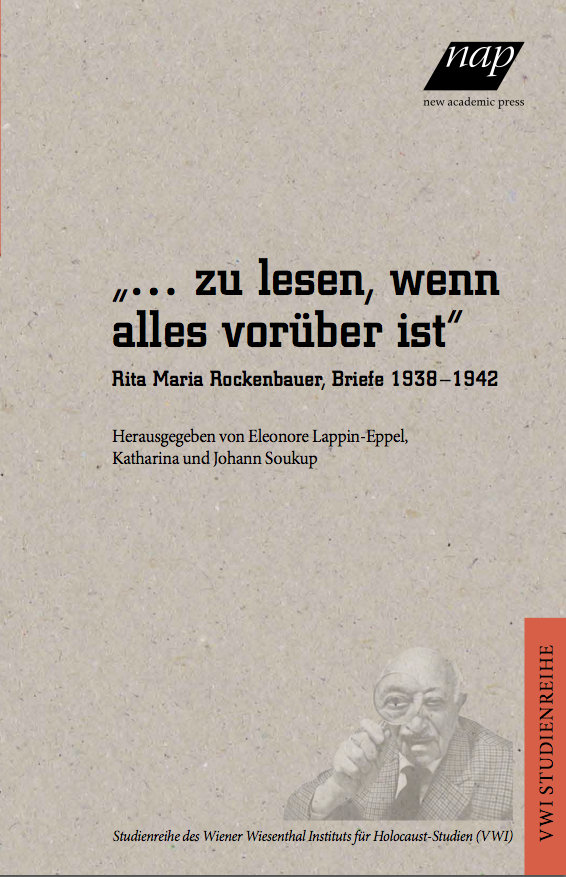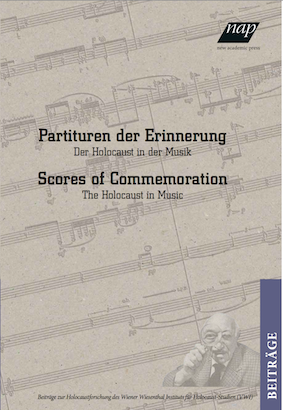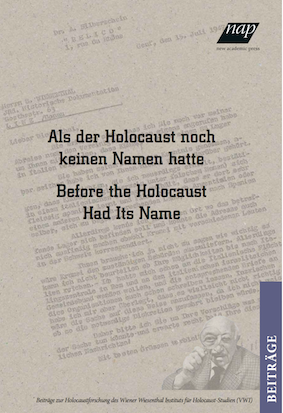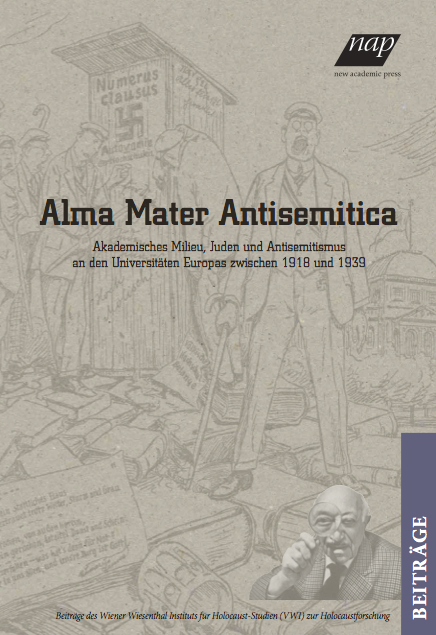 In his Simon Wiesenthal Lecture, the British historian Robert Knight attempted to trace the fates of his grandparents in their political, human, and familial contexts, and to discern the roots of their thoughts and actions. Heinrich Scheuer remained not only connected but deeply loyal to the state of Austria in all its incarnations through the first half of the twentieth century. Alice Scheuer was dedicated to Austrian modernity and its avantgarde. Their Jewish backgrounds were hardly relevant, identity – as the historian was able to deduce from the available documentation – was not a question to them, or if it did, it did so only in the background, not noticeably or even discernibly. It was only of importance to the others: The conflicts already reached a climax under the Dollfuß dictatorship. Following the ‘Anschluß’, their two children – Georg and Rose – manage to escape. The parents remained, were deported to Maly Trostenets, and murdered. It would take a long time for the children to come to terms with their parents’ past, which left many unanswered questions, resonating even among their descendants.
In his Simon Wiesenthal Lecture, the British historian Robert Knight attempted to trace the fates of his grandparents in their political, human, and familial contexts, and to discern the roots of their thoughts and actions. Heinrich Scheuer remained not only connected but deeply loyal to the state of Austria in all its incarnations through the first half of the twentieth century. Alice Scheuer was dedicated to Austrian modernity and its avantgarde. Their Jewish backgrounds were hardly relevant, identity – as the historian was able to deduce from the available documentation – was not a question to them, or if it did, it did so only in the background, not noticeably or even discernibly. It was only of importance to the others: The conflicts already reached a climax under the Dollfuß dictatorship. Following the ‘Anschluß’, their two children – Georg and Rose – manage to escape. The parents remained, were deported to Maly Trostenets, and murdered. It would take a long time for the children to come to terms with their parents’ past, which left many unanswered questions, resonating even among their descendants.
Editorial
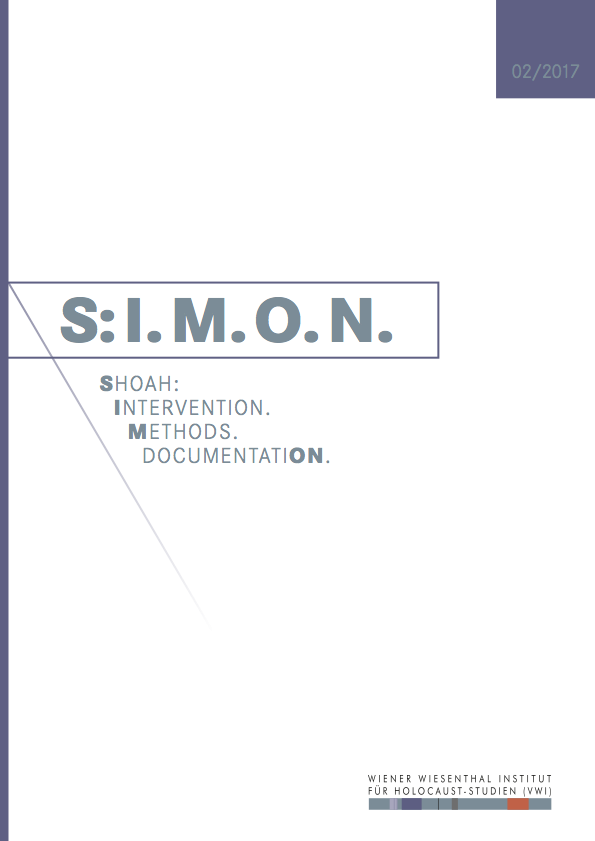 S:I.M.O.N. is an e-journal of the Vienna Wiesenthal Institute for Holocaust Studies (VWI). It appears twice a year in English and German language. S:I.M.O.N. aims at both a transnational and comparative history of the Holocaust and Jewish Studies in Central and Eastern Europe within the broader contexts of the European history of the 20th and 21st century, including its prehistory, consequences and legacies as well as the history of memory.
S:I.M.O.N. is an e-journal of the Vienna Wiesenthal Institute for Holocaust Studies (VWI). It appears twice a year in English and German language. S:I.M.O.N. aims at both a transnational and comparative history of the Holocaust and Jewish Studies in Central and Eastern Europe within the broader contexts of the European history of the 20th and 21st century, including its prehistory, consequences and legacies as well as the history of memory.
S:I.M.O.N. serves as a forum for discussion of various methodological approaches. The journal especially wishes to strengthen the exchange between researchers from different scientific communities and to integrate both the Jewish history and the history of the Holocaust into the different “national” narratives. It also lays a special emphasis on memory studies and the analysis of politics of memory. S:I.M.O.N. uses a double-blind review system, which means that both the reviewer’s and the author’s identities are concealed from each other hroughout the review process.
Shoah: The journal deals with the history of the Shoah from multidisciplinary, transnational and comparative perspectives. It seeks to integrate studies on Jews as well as on other groups of victims of the Holocaust, especially on Roma, and of so far less researched regions of (East) Central and (South) Eastern Europe.
Intervention. The journal reports on research projects and their transmission into public events. It also informs about current educational and remembrance programs.
Methods. The journal serves as a forum for the discussion of methodological approaches as, for instance, the everyday history, oral history, gender history, the history of violence, anti-Semitism and racism and the theory of memory and memory politics.
DocumentatiON. The journal contributes to critical approaches on using and interpreting archival materials in the 21st century.
Download the current issue S:I.M.O.N. 2017/2.
Articles
Gerhard Baumgartner
The Road Towards Genocide. The Process of Exclusion and Persecution of Roma and Sinti in the 1930s and 1940s
 The fate of the European Roma during the Holocaust, the murder of several hundreds of thousands of Roma and Sinti in the territories under control of the Third Reich – a genocide which by Roma and Sinti representatives is also referred to as 'Porrajimos' or 'Samusdripen' – now forms an accepted part of European historical discourse on the 20th century and has become the focal point of a new Europe-wide process of Roma identity formation. In its monstrosity and unprecedented brutality it is like a vast shadow cast upon the common history of Roma and Gadje alike, a memento of an unspeakably dehumanised past.
The fate of the European Roma during the Holocaust, the murder of several hundreds of thousands of Roma and Sinti in the territories under control of the Third Reich – a genocide which by Roma and Sinti representatives is also referred to as 'Porrajimos' or 'Samusdripen' – now forms an accepted part of European historical discourse on the 20th century and has become the focal point of a new Europe-wide process of Roma identity formation. In its monstrosity and unprecedented brutality it is like a vast shadow cast upon the common history of Roma and Gadje alike, a memento of an unspeakably dehumanised past.
Historians have reconstructed the events that culminated in these murderous acts in great detail, mapping the increasingly radical acts of marginalisation and persecution of people labelled as 'Zigeuner' ('Gypsies') by the authorities. This marginalisation started during the Romantic period, when Europeans were told to see 'Gypsies' as fundamentally different and exotic – the 'last savages of Europe'. This, combined with the emerging 'science' of eugenics, which declared these differences to be genetically determined and therefore immutable, prepared the ground for their marginalisation and exclusion from society, based on pseudoscientific concepts.
A severe social crisis caused by the global economic crisis of the 1930s, aggravated by the lack of adequate social welfare systems in Central and Eastern Europe at the time, led to clashes between the Roma and non-Roma populations, especially in the formerly Hungarian, now Austrian, Burgenland region. This later provided the justification for the Nazi administration's racist policies against Roma and Sinti, which eventually culminated in genocide. Some key ingredients in this catastrophe may seem strangely familiar now, as we can again encounter them in Europe today. Looking at the policies that paved the way for the Nazi genocide of the 'Gypsies', it becomes clear that many of today's policies and administrative practices affecting Roma, especially in Eastern Europe, are not that new after all and have worrying echoes in the past.
SWL-Reader
Irina Scherbakowa
Erinnerung versus Verdrängung am Beispiel Russland. Vom schwierigen Umgang mit der Vergangenheit
 There is a paradox saying in contemporary Russia that a country's past cannot be predicted: the image of the Russian or Soviet past is always influenced by the interpretation of the current political situation. In order to be able to understand why Russia is once again in the smothering hold of an “unpredictable past” and why one's attitude to Stalin is still, 62 years after his death, the sole measure for a person's position on democracy and liberal values, we must take a closer look at the social conditions during the second half of the 1980s. This paper addresses that task. Its particular focus is the construction of an official state ideology from contradictory historical images by the ruling elites in contemporary Russia.
There is a paradox saying in contemporary Russia that a country's past cannot be predicted: the image of the Russian or Soviet past is always influenced by the interpretation of the current political situation. In order to be able to understand why Russia is once again in the smothering hold of an “unpredictable past” and why one's attitude to Stalin is still, 62 years after his death, the sole measure for a person's position on democracy and liberal values, we must take a closer look at the social conditions during the second half of the 1980s. This paper addresses that task. Its particular focus is the construction of an official state ideology from contradictory historical images by the ruling elites in contemporary Russia.
Events
Miloslav Szabó
Ein ‚antislowakischer' Oscar-Film? Zur Darstellung des Holocaust im tschechoslowakischen Film Obchod na korze
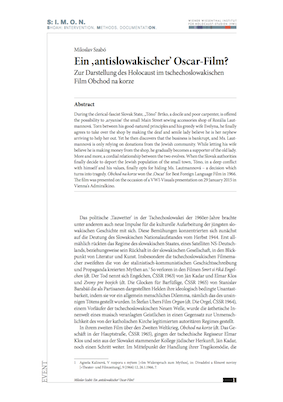 During the clerical-fascist Slovak State, "Tóno" Brtko, a docile and poor carpenter, is offered the possibility to 'aryanise' the small Main Street sewing accessories shop of Rozália Lautmannová. Torn between his good-natured principles and his greedy wife Evelyna, he finally agrees to take over the shop by making the deaf and senile lady believe he is her nephew arriving to help her out. Yet he then discovers that the business is bankrupt, and Ms. Lautmannová is only relying on donations from the Jewish community. While letting his wife believe he is making money from the shop, he gradually becomes a supporter of the old lady. More and more, a cordial relationship between the two evolves. When the Slovak authorities finally decide to deport the Jewish population of the small town, Tóno, in a deep conflict with himself and his values, finally opts for hiding Ms. Lautmannová – a decision which turns into tragedy. Obchod na korze won the 'Oscar' for Best Foreign Language Film in 1966. The film was presented on the occasion of a VWI-Visuals presentation on 29 January 2015 in Vienna's Admiralkino.
During the clerical-fascist Slovak State, "Tóno" Brtko, a docile and poor carpenter, is offered the possibility to 'aryanise' the small Main Street sewing accessories shop of Rozália Lautmannová. Torn between his good-natured principles and his greedy wife Evelyna, he finally agrees to take over the shop by making the deaf and senile lady believe he is her nephew arriving to help her out. Yet he then discovers that the business is bankrupt, and Ms. Lautmannová is only relying on donations from the Jewish community. While letting his wife believe he is making money from the shop, he gradually becomes a supporter of the old lady. More and more, a cordial relationship between the two evolves. When the Slovak authorities finally decide to deport the Jewish population of the small town, Tóno, in a deep conflict with himself and his values, finally opts for hiding Ms. Lautmannová – a decision which turns into tragedy. Obchod na korze won the 'Oscar' for Best Foreign Language Film in 1966. The film was presented on the occasion of a VWI-Visuals presentation on 29 January 2015 in Vienna's Admiralkino.
Robert Knight: Wer waren Heinrich und Alice Scheuer? Erkund(ig)ungen eines Enkelkindes
„... zu lesen, wenn alles vorüber ist“
Rita Maria Rockenbauer, Briefe 1938 –1942
Wien 2014
Partituren der Erinnerung.
Der Holocaust in der Musik
Scores of Commemoration.
The Holocaust in Music
Wien 2015
Before the Holocaust Had Its Name. Early Confrontations of the Nazi Mass Murder of the Jews
Wien 2016
Akademisches Milieu, Juden und Antisemitismus an den Universitäten Europas zwischen 1918 und 1939
Academic Milieu, Jews and Antisemitism at European Universities between 1918 and 1939
Wien 2016



